Intermediate relay (Immediate relay in English) is an extremely important device in industrial and civil electronic circuit boards. It plays an intermediary role in transmitting signals from the PLC/microprocessor control block to the high-power dynamic block such as contactors, switchgear, ...
So what really is an intermediate relay? How is it classified and how is it connected? Please read the article below for the most general overview.
1) What is an intermediate relay?
An intermediate relay (Intermediate relay) is an electronic device similar to an electromagnet with an integrated contact system. They have the function of switching control signals and amplifying them in a small size. Because it is installed in an intermediate position in the electrical diagram, the intermediate relay has this name. More specifically, it is arranged between the small power control device and the large power control device.
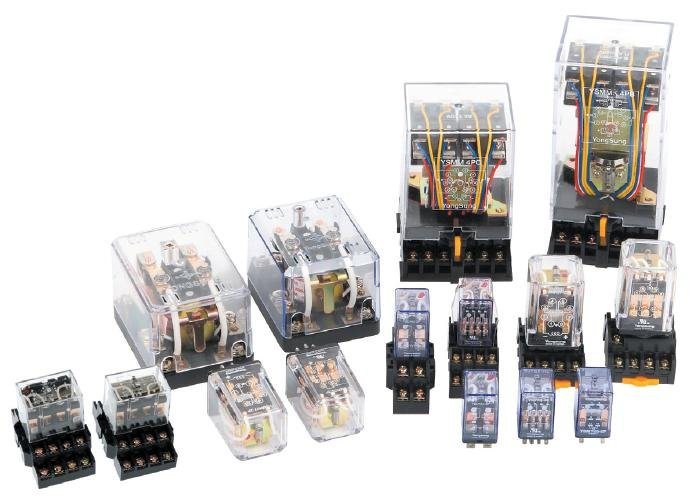
What is an intermediate relay?
Although it is a small device, the glass relay is extremely important in the electrical circuit. This electronic device needs to be installed mostly on electronic circuit boards. It is a type of switch because the relay has two states: ON and OFF. Which state they are in depends on whether there is current flowing through the relay or not.
In case you need to use an intermediate role:
The most common and familiar is the relay installed in the refrigerator protection unit. When the current is weak, the relay automatically turns off the power to ensure electrical safety for the refrigerator, and when the current is stable, the relay closes to supply power to the refrigerator to operate normally again.
The second most common example is in the lighting circuit of a car. On this modern vehicle, light switches integrated into the turn signals or dashboard will not activate the headlight circuit directly. Instead, they all use a lighting control module (LCM) or some other power distribution module.

Car lighting circuit diagram
When the headlight switch is on, the LCM receives this action as input to change the headlights, parking lights, and tail lights to the on state. And to do this, the LCM activates the output circuit that controls each lighting circuit by energizing intermediate relays. When a switch cannot receive a command to turn on one circuit and not turn on another circuit, a relay located in an intermediate position will receive energy from the LCM as well as transmit a signal to handle that task.
2) Structure and operating principle of intermediate relay
2.1) Structure:

The general structure of an intermediate relay includes two main parts: the attraction coil (electromagnet) and the contact circuit (force circuit).
The electromagnet consists of a dynamic steel core, a static steel core, and a coil. That coil can be an amperage coil or a voltage coil, or it can be both. The moving steel core is secured by a spring and co-located by an adjusting screw.
The contact circuit includes a reverse contact that plays the role of switching the load electrical device and is isolated from the suction coil by a small current.
In addition, other parts such as protective covers and contact pins must be mentioned.
2.2) Operating principle:
The operating principle of an Intermediate Relay is similar to a Contactor but there are still differences. When a voltage equal to the rated voltage value is applied to the two coil ends of the intermediate Role, the electromagnetic force draws the magnetic circuit closed, the contact system will change state and remain in this state. The normally closed contact will open, the normally open contact will close. When the power supply is stopped, the magnetic circuit is open, and the contact system returns to its original state. Just like that, this operating principle is repeated.
3) Classification of Immediate relay
Immediate relay are divided into many different types to meet many purposes. Usually they are identified in two main ways by the number of pins and by the number of volts.
-
3.1) Classify intermediate relays by number of pins
- As the name suggests, intermediate relays based on pins are distinguished by the number of pins of that type of relay. The most popular on the market today are:
8-pin intermediate relay
The 8-pin intermediate relay is simply that it is designed to have 8 pins. The main task of this type of glass relay is to carry the intermediate load for the sensors. In addition, it also makes self-holding, opening, and turning circuits with a design with many surrounding contacts.
8-pin glass relays are very popular among electrical engineers due to their ease of installation and disassembly, as well as their high durability and stability during use.
14-pin glass relay
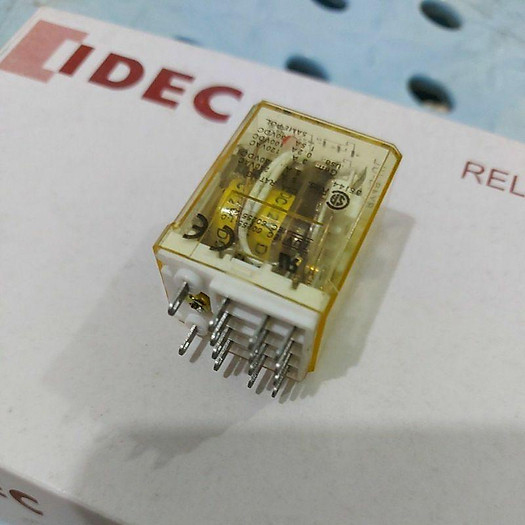
The 14-pin intermediate relay actually has a total of 4 pairs of contacts. In which 13 and 14 are always the power supply coil pins. With its excellent uses, performance and safety for civil/industrial power systems, the 14-pin intermediate relay is very popular.
In addition to the two types of relays mentioned above, there are also 5-pin relays, 8-pin relays and 11-pin relays.
3.1) Classify intermediate relays according to the number of volts
Choosing an intermediate role according to the number of volts is very suitable for application in civilian devices. This will minimize the risk of damage, fire and explosion to electrical equipment in the house.
Glass relay 220V

The 220V intermediate relay has many contacts. Can also be both open and closed, so it is often used to transmit signals when the main relay cannot guarantee the ability to turn off. They also have high durability and safety, so they will save significant costs for your family.
With two independent 220V intermediate relay circuits, the structure assists electricians more easily in installation and maintenance. The structure of this relay is not too complicated so you can easily install and check during use.
380V intermediate relay
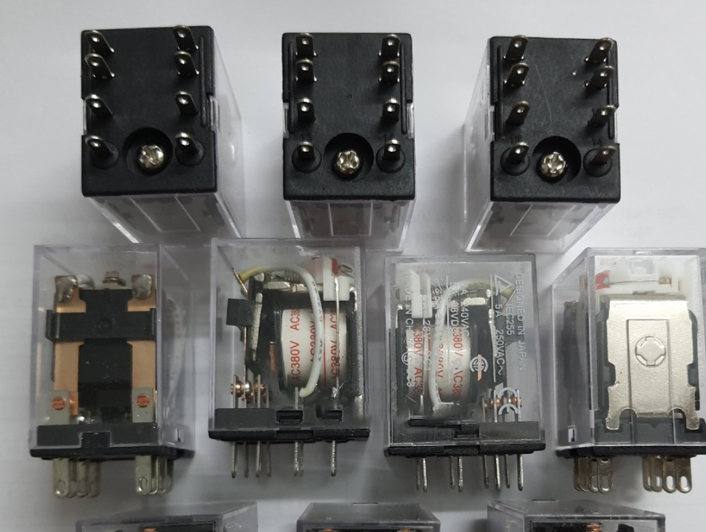
The 380v intermediate relay has a load capacity of up to 100 amperes. Besides, the super fast impact time is only 0.1s, very suitable for use in industrial equipment.
Some other advantages include the large contact size, which is super durable and sturdy, limits phase loss and short circuits, and optimizes working performance.
Even if it runs with extremely high current capacity like industrial machines, it will still maintain a stable power flow for the factory.
4) Role of glass relay in control circuit
Intermediate relays are widely used in control systems of both modern industrial and household appliances. For different control lines, its role will be different. The role of glass relays in conventional lines can be divided into:
4.1) Replacement for contactor (magnetic starter)
The contacts of the intermediate relay have a certain load capacity. And it can be used as a substitute for intermediate relays when the load capacity is small. Especially in controlling electric rolling doors and small household appliances, the relay not only plays a control role but also saves a certain amount of space. At the same time, it allows for relatively delicate control of the device's electrical part.
4.2) Increase exposure
Although the contact capacity of the intermediate relay is not large, it has a certain load-bearing capacity and only requires a small current to operate. For example, a sensor switch cannot be used directly, or when the output of a triode is used to control relatively large electrical components of a load. We can use an intermediate relay as a medium to expand the contact capacity.
4.3) Use as a switch
In a part of the control circuit, the immediate relay plays the role of opening and closing control. For example, color TVs and automatic degreasing circuits are commonly used in monitors, the internal triode controls the on/off of the intermediate relay, and also plays the role of on/off control of the degreasing coil.
4.4) Receive 1 or more control signals
Receiving control signals is an extremely popular application in circuit control. It will solve the problem whether there are one or more contactors or other components.
4.5) Converts voltage and eliminates circuit noise
Although there are many types of protection and anti-interference measures in industrial control and computer control lines, this type of interference still exists to some extent
4.6) Switch contact type
This type of contact switch is commonly used in industrial electrical control systems. The control process requires the use of normally closed contacts of the magnetic starter to achieve the purpose of control. Since the normally closed contacts of the magnetic starter itself have been used up, the control work is completed. At this time, the intermediate relay and the original contactor coil can be connected in parallel.
The principle is that the normally closed contact of the intermediate relay can control the corresponding component to reach the switching contact type, to complete the control task smoothly.
5) Technical specifications of intermediate relay
I will list out the most common parameters on the line of glass relay devices:
Voltage: 220VAC, 220VDC, 110VDC, 110VAC, 48VDC, 48VAC, 24VDC, 12VDC.
Contact: Silver alloy.
Temperature: -40-55 degrees Celsius.
Number of switching times: 100,000 times.
Rated current: 10A, or 5A.
Foot type: Round foot, small flat foot, large flat foot 10A.
Number of pins: 14 small flat pins 5A, 14 large flat pins 10A, 8 small flat pins, 8 large flat pins 10A, 11 round pins, 8 round pins 10A.
6) Application of intermediate relay in practice
Intermediate relays are widely used in industrial equipment with the intermediate task of relaying electrical circuits to other devices. Relay also helps protect devices and prolong their lifespan. Relays are also used to divide electrical signals to components in the control circuit system.
The intermediate relay is also the output part and can isolate the voltage between the executive parts such as AC, large voltage,... and the control part.
Executive part: AC power with high voltage 220V-380V.
Control part: low voltage DC 9V-24V.
In fact, people also use intermediate relays to transmit signals or electromagnetic loops of several Ampere.
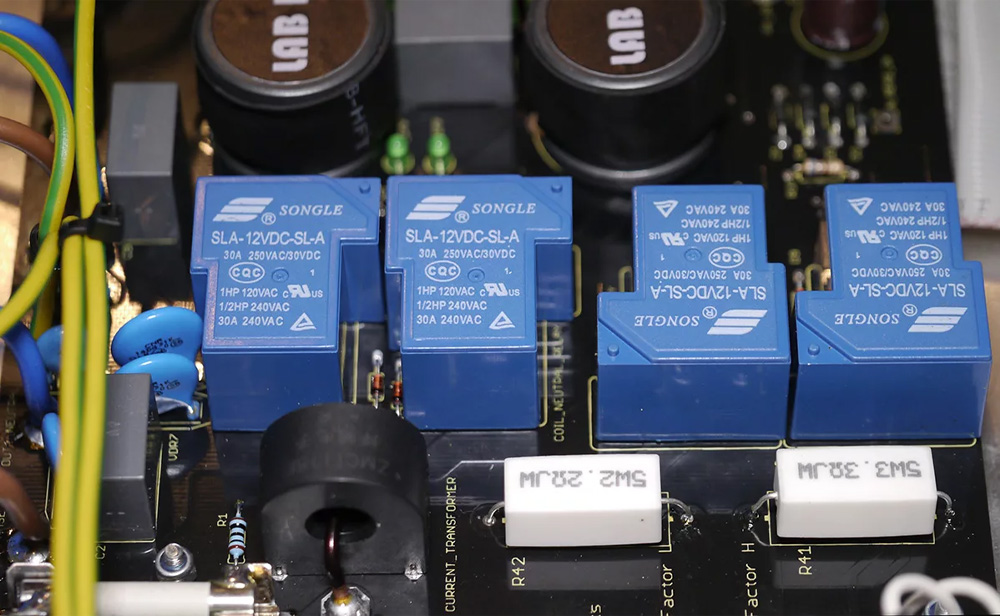
7) How to connect intermediate relay
7.1) 8-pin connection
The 8-pin relay has 2 power supply pins and 2 pairs of control contacts.

According to the 8-pin relay diagram above, we will see 2 pairs of normally closed and normally open contacts. Connect 12-24-220V power to pins 1 and 5. Pins 2-4, 6-8 are 2 pairs of normally open contacts. The remaining 2-3 and 6-7 are two normally closed pairs.
According to the picture, we connect 12 - 24 - 220V power supply depending on the type to pins 1 and 5 of the coil. In which 2 pairs of normally open contacts are 2-4 and 6-8. The two pairs that are usually played are 2-3 and 6-7
Same principle as 4 or 5 pin relay. In the 8-pin relay line, when there is no power, pairs 2-4 and 6-8 are normally open. 2-3 and 6-7 are normally closed forms.
When we apply power, 2-4 and 6-8 immediately close as shown above. At the same time, the other two pairs of poles open.
7.2) 14-pin type connection
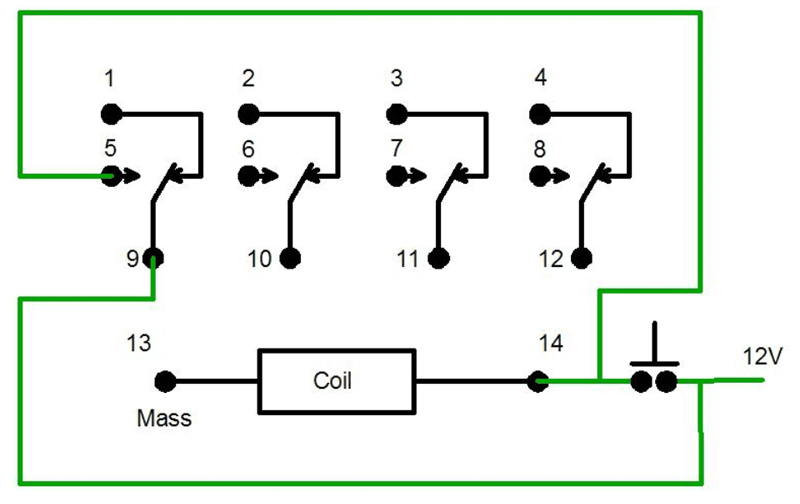
A 14-pin relay has a total of 4 pairs of contacts. In there:
Pins 1 2 3 4 are NC (normally closed)
Pins 5 6 7 8 are NO (normally open)
Pins 9 10 11 12 are COM.
Pins 13 and 14 are the voltage supply pins for the Coil.
As for the 14-pin glass relay, it actually has a total of 4 pairs of contacts. Where 13 and 14 are always the power supply coil pins.
8) The best intermediate relay brands on the market
There are quite a few brands on the market that provide intermediate relays, the most typical of which are:
Brand of European origin: Schneider.
Brands of Japanese origin: Idec, Omron, Fuji, Chint...
Brands made in Korea: Hanyoung, Youngsung,...
Chinese and Taiwanese brands: Taiwan Meter, Kacon,...
8.1) IDEC intermediate relay

IDEC has many lines of intermediate relays such as:
RJ series (small relay)
RU series (standard, high-end relay)
RY series (standard relay, 4-pole, economical)
RM series (standard relay, 2-pole, economical)
RR series (large relay, round pins)
RH series (large relay, flat pin)
Among them, the RJ series, RU series, and RY series are the most popular.
Specifications
- Compact design, thickness is only 12.7 mm
Withstand large current:
- RJ1S (1 pole): 12 A
- RJ2S (2 poles): 8 A
The number of mechanical and electrical opening and closing times is very high
Number of opening and closing times: 200,000 (AC load)
Number of mechanical opening and closing times: 30,000,000 (AC load)
Environmentally friendly design, according to RoSH standards
Does not contain substances toxic to the environment such as: Lead, Mercury, PBB, Chromium...
Built-in Diode type to resist reverse voltage up to 1000V
Reference Rơ le trung gian IDEC
8.2) Schneider intermediate relay
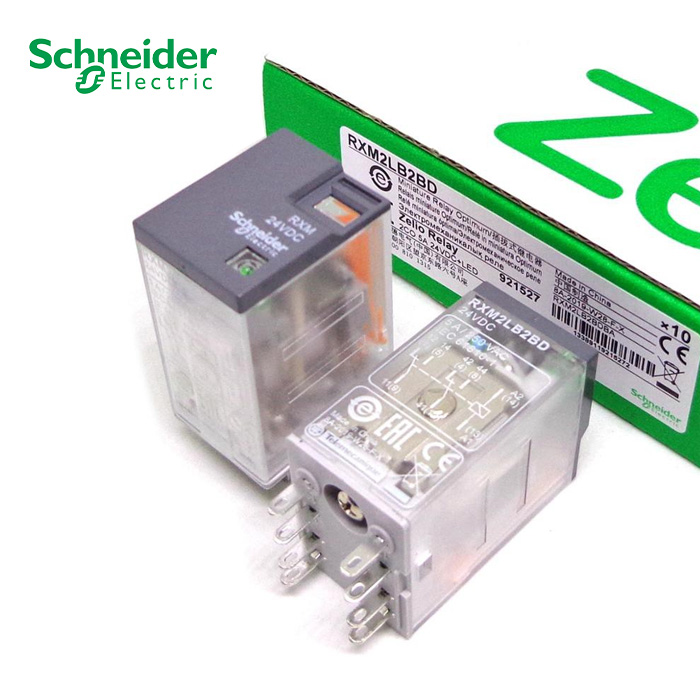

Among Relay types, the Schneider Intermediate Relay product line offers many advantages with maximum simplicity and performance for automation systems.
Intermediate relays of this European brand are often designed with compact size and weight to save installation space, and can be moved or carried when used. Being made from high-quality, sustainable materials helps ensure maximum safety when used. Especially because of its low price and high performance, it is very popular with global consumers. In addition, the ability to work in harsh environmental conditions: dust, high temperature,... is an extremely outstanding advantage of Schneider relays.
Refer to genuine Schneider intermediate relays: https://amazen.com.vn/relay-trung-gian/schneider.html
The Schneider immediate relay line meets a number of manufacturing standards:
Manufactured according to EN/IEC 61810-1, UL 508, CSA C22.2 No 14 standards, certified by CSA, UL, REACH, Lloyd's, RoHS, GOST, CE.
Meets EN/IEC 60529 standards. Strictly complies with environmental standards and achieves quality standards such as: CSA, UL, REACH, Lloyd's, RoHS, GOST, CE. With the above advantages, users can feel completely secure when choosing and using this product.
Meets IEC/EN 60669-2-2, IEC/EN 60947-5-1, IEC/EN 60947-3 standards. IP40 protection standard
8.3) Omron glass relay
Made from electromagnets and a system of switching contacts, with a compact, modular design, easy to install and replace. We can see that OMRON Relays are used a lot in the electronics industry, especially integrated in electrical cabinets, control cabinets and industrial machinery systems.
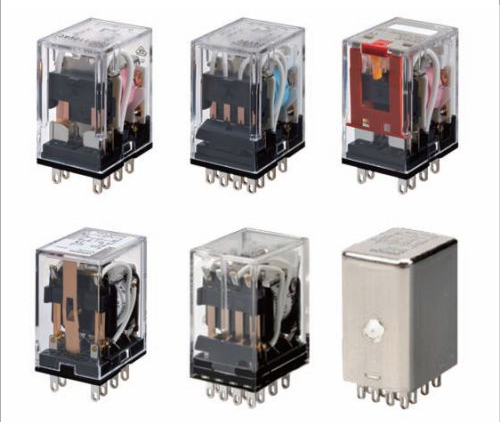
Common operating voltage levels in industrial environments of Relay Omron are 12VDC, 24VDC and 110VAC or 224VAC. With 1-contact, 2-contact, 4-contact types, people often specify pins such as 8-pin, 11-pin, 14-pin relays, flat and round types, etc. All technical specifications and connection diagrams are included with the Omron Relay Catalog or are engraved directly on the device, making it convenient for anyone to install and check.
Omron intermediate relay with good price: https://amazen.com.vn/relay-trung-gian/omron.html
8.4) CHINT intermediate relay
Chint intermediate relays are a high-quality relay product line that accounts for 70% of orders in the high-end segment. Manufactured by CHINT - The leading electrical equipment brand in China, this line of electronic equipment uses the most advanced technology and possesses many superior features, providing high stability and absolute safety for user.
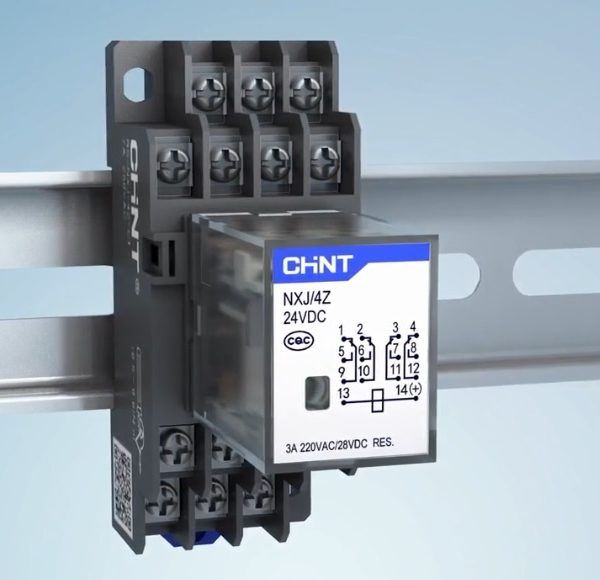
Chint intermediate relays are widely trusted for industrial electrical systems, factories, automation lines, civil and industrial construction projects, and power stations from low voltage to high voltage. They are trusted and safe to use by electrical engineers for high-rise buildings, high-end resorts, airports, wharves, etc. because of the highest current breaking ability, optimal technical combination (stratification and filtration), safety, high durability and especially suitable for hot, humid and rainy environments in Vietnam.
Maybe you are interested: Rơ le trung gian Chint
Epilogue
Above is all the most important content about the intermediate relay product line. Hopefully the article content will assist you in the process of learning, choosing to buy and operate this line of automation equipment.
In case you need to buy an intermediate relay or have questions or need further advice, please contact Amazen via:
Hotline: 0934 399 068 - Sales: 0938 072 058
Email: amazen@amazen.com.vn